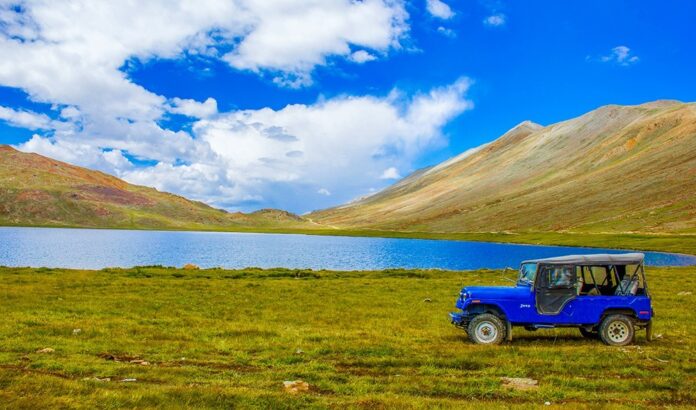A beautiful place with a mysterious history, Deosai national park is located in Skardu and spreads over an area of 3626 sq. km. Deosai Skardu is heavenly and is accessible only in summer. For this reason, the locals call it ‘Ghbiarsa’ in the Balti language.
The word Deosai is derived from two words, Deo which refers to ‘spirits’, and Sai which refers to ‘sitting place’. Combining both words means ‘A place of spirits, as it was believed in ancient times that the place was inhabited by spirits. The national park is one of the most beautiful landmarks in Gilgit Baltistan.
History
The location was once an important route of trade between Kashmir and Gilgit as well as the before the partition of the subcontinent. A park is a place where man wars were held as well as many tribal conflicts were solved. Local tribes, Dogras, and the Turks fought many wars in the plains of Deosai National Park. The park was declared the National Park by the government of Gilgit-Baltistan on 14th May 1993. According to the categories of protected areas by IUCN, Deosai National Park comes in category I for the conservation and protection of endangered species like the Himalayan Bear.
Geographic Location
The geographic location of the park is very interesting and makes it a principal territory. It is due to the reason that park is situated close to the line of control with India in Indian-held Kashmir. The location is beautiful as it is at the junction of western Himalaya, Zanskar, and the Ladkh mountain ranges.
The park is divided into big and small deosai. The big deosai is almost 30 km and is situated on the southern side of Skardu. You can reach this part from the North via a jeep from Skardu and you will enter the plateaus through Ali Malik Pass. The road to Bara deosai crosses the plateaus and leads to Astore valley via Sheosar pass in the West near the lake. The bara deosai fortresses the Brown Bear.

Deosai National Park Landmarks
Deosai top enjoys an altitude of 3500 – 5200 meters and is a picturesque alpine plateau with wonders of nature. On your trip to Gilgit Baltistan, do not forget to visit this magnificent park. There are rolling hills protruding from the plateau. The whole plateau lies in the heart of the mountains of the Himalayas, Nanga Parbat, and Karakorum ranges.
During winter, the park gets covered in snow that is not accessible. The weather is extremely cold combined with low oxygen and carbon dioxide levels as well as low atmospheric pressure. People with breathing problems should take precautionary measures. The plains experience more rainfall than the surrounding areas. The annual precipitation is recorded in the range of 350 – 550 mm in winter mostly as snow.
The park is known for its enriched biodiversity as it rests at the geographical location where two provinces merge. In the Karakoram-Pamir and Himalayan highlands. There are big stretches of alpine meadows and some dry stony areas well. Snow melts into rivers and streams enhancing the beauty of the park. The dwarf willow patches alongside the streams and rivers are a thrilling location and inhabit many species of Poa, Euphorbia, and Saxifraga.
The three beautiful river systems that originate from the park are Bara Pani, shatuna, and Kala Pani. They drain into the shigar river which is a main tributary of the Indus River.
Deosai National Park is a biodiversity hotspot and conserves many endangered species. There is a population of Himalayan ibex, Tibetan wolf, Tibetan red fox, and golden marmots. There are also snow trout living in the waters of the park. Himalayan brown bear, one of the popular endangered species resides there. Bears commonly used as baiting are also now declared endangered by IUCN and deosai park homes have a stable population of bears. Almost 72 bears are reported at the park.

Deosai park is also a part of Birdlife International’s western Himalaya endemic bird area and serves as home to many migratory and residential birds. The floral life of the park is also unique and harbors hundreds of aromatic and medicinal species. During the spring season, the park gets covered with many wildflowers and you will see many beautiful and rare butterflies.

Sheosar lake and Deosai National Park are among the highest elevation of freshwater wetlands worldwide. Its cold alpine weather is due to the extended diversity of alpine flora and many other species.
Deosai national park has also been made to the tentative list of UNESCO world heritage sites.
End Note
You will not see the permanent residents in Deosai plain owing to the extreme cold in winter as well as due to the remoteness of the area. Tourism is also limited as the park is not accessible during winter. During the summer season, some tourists come to enjoy the place. The traditional grazing rights are also restricted to only 7 communities within the said boundaries. The allowed communities can take livestock to pastures in summer only in designated areas of the park. The article sums up everything you need to know about Deosai National Park Skardu.


